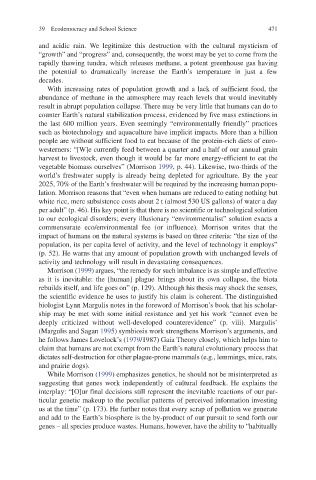Page 496 - Cultural Studies of Science Education
P. 496
39 Ecodemocracy and School Science 471
and acidic rain. We legitimize this destruction with the cultural mysticism of
“growth” and “progress” and, consequently, the worst may be yet to come from the
rapidly thawing tundra, which releases methane, a potent greenhouse gas having
the potential to dramatically increase the Earth’s temperature in just a few
decades.
With increasing rates of population growth and a lack of sufficient food, the
abundance of methane in the atmosphere may reach levels that would inevitably
result in abrupt population collapse. There may be very little that humans can do to
counter Earth’s natural stabilization process, evidenced by five mass extinctions in
the last 600 million years. Even seemingly “environmentally friendly” practices
such as biotechnology and aquaculture have implicit impacts. More than a billion
people are without sufficient food to eat because of the protein-rich diets of euro-
westerners: “[W]e currently feed between a quarter and a half of our annual grain
harvest to livestock, even though it would be far more energy-efficient to eat the
vegetable biomass ourselves” (Morrison 1999, p. 44). Likewise, two-thirds of the
world’s freshwater supply is already being depleted for agriculture. By the year
2025, 70% of the Earth’s freshwater will be required by the increasing human popu-
lation. Morrison reasons that “even when humans are reduced to eating nothing but
white rice, mere subsistence costs about 2 t (almost 530 US gallons) of water a day
per adult” (p. 46). His key point is that there is no scientific or technological solution
to our ecological disorders; every illusionary “environmentalist” solution exacts a
commensurate eco/environmental fee (or influence). Morrison writes that the
impact of humans on the natural systems is based on three criteria: “the size of the
population, its per capita level of activity, and the level of technology it employs”
(p. 52). He warns that any amount of population growth with unchanged levels of
activity and technology will result in devastating consequences.
Morrison (1999) argues, “the remedy for such imbalance is as simple and effective
as it is inevitable: the [human] plague brings about its own collapse, the biota
rebuilds itself, and life goes on” (p. 129). Although his thesis may shock the senses,
the scientific evidence he uses to justify his claim is coherent. The distinguished
biologist Lynn Margulis notes in the foreword of Morrison’s book that his scholar-
ship may be met with some initial resistance and yet his work “cannot even be
deeply criticized without well-developed counterevidence” (p. viii). Margulis’
(Margulis and Sagan 1995) symbiosis work strengthens Morrison’s arguments, and
he follows James Lovelock’s (1979/1987) Gaia Theory closely, which helps him to
claim that humans are not exempt from the Earth’s natural evolutionary process that
dictates self-destruction for other plague-prone mammals (e.g., lemmings, mice, rats,
and prairie dogs).
While Morrison (1999) emphasizes genetics, he should not be misinterpreted as
suggesting that genes work independently of cultural feedback. He explains the
interplay: “[O]ur final decisions still represent the inevitable reactions of our par-
ticular genetic makeup to the peculiar patterns of perceived information investing
us at the time” (p. 173). He further notes that every scrap of pollution we generate
and add to the Earth’s biosphere is the by-product of our pursuit to send forth our
genes – all species produce wastes. Humans, however, have the ability to “habitually

